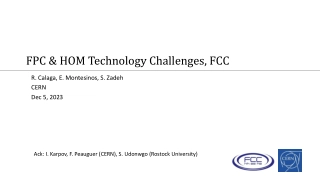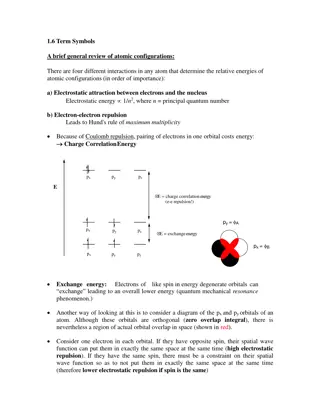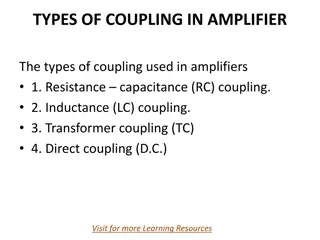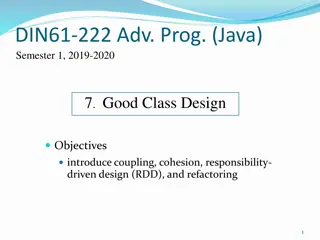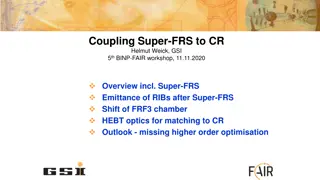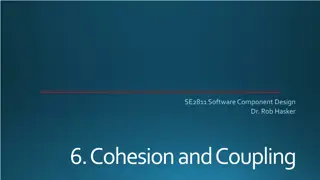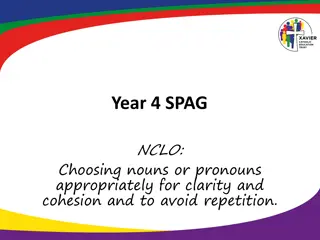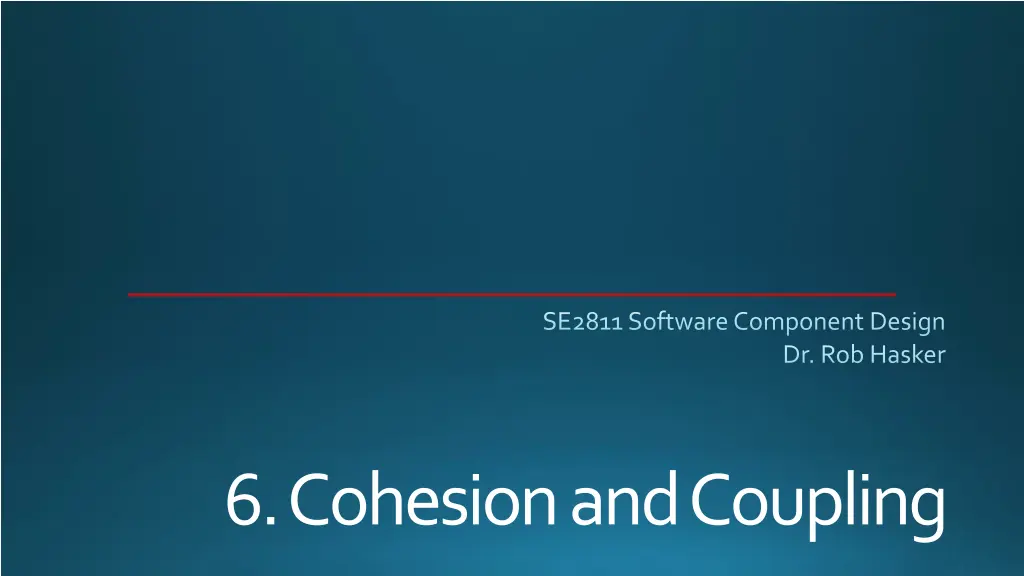
Understanding Software Component Design Principles
Explore the challenges and strategies involved in software component design, including cohesion, coupling, and patterns like Adapter, Strategy, and Singleton. Learn about improving system design through low coupling and high cohesion, and understand the importance of interconnections between modules in software systems.
Download Presentation

Please find below an Image/Link to download the presentation.
The content on the website is provided AS IS for your information and personal use only. It may not be sold, licensed, or shared on other websites without obtaining consent from the author. If you encounter any issues during the download, it is possible that the publisher has removed the file from their server.
You are allowed to download the files provided on this website for personal or commercial use, subject to the condition that they are used lawfully. All files are the property of their respective owners.
The content on the website is provided AS IS for your information and personal use only. It may not be sold, licensed, or shared on other websites without obtaining consent from the author.
E N D
Presentation Transcript
SE2811 Software Component Design Dr. Rob Hasker 6. Cohesion and Coupling
Knowing what the parts DO! What are the challenges of each? Finding the parts to change Which would you rather do? Knowing what happens when you change them Knowing how to put them back together again How they connect Hellion Twin Turbo - Complete Kit (15-17 GT) Change a diaper? File:Baby.jpg Change a fuel filter?
Software systems Understanding a class Large numbers of responsibilities: difficult to understand Small number, closely related: much easier to understand Classes with a small number of closely related responsibilities: cohesive True for methods, packages, etc.: want closely related responsibilities General goal: high cohesion Understanding relationships between classes Interconnectivity between two classes: known as the coupling High coupling: a change in one class means changes in the other Goal: low coupling between components
Improving coupling, cohesion How does the Adapter Pattern improve system design? How does the Strategy Pattern improve system design? What does the Singleton Pattern do to improve design? Note: Adapter: structural pattern Strategy: behavioral pattern Singleton: creational pattern
Coupling Measure of interconnection between modules Goal: low coupling Simple connections between modules Note: modules Typically classes, but also packages, individual methods Will focus on classes for now
Consider class Student { private String firstName = "Sampath"; } Student stu = new Student(); System.out.println(stu.firstName); // ERROR!
import java.lang.reflect.Field; # output class Student { private String firstName = "Sampath"; } Value of firstName: Sampath Value of firstName after changing: Trisha public class TestReflection { public static void main(String args[]) throws Exception { Student someStudent = new Student(); Field fs = someStudent.getClass().getDeclaredField("firstName"); fs.setAccessible(true); Makes field accessible by both get, set System.out.println("Value of " + fs.getName() + ": " + fs.get(someStudent)); fs.set(someStudent, "Trisha"); System.out.println("Value of " + fs.getName() + " after changing: " + fs.get(someStudent)); } } Consequences?
Content Coupling Content Coupling: using data, control encapsulated within the boundary of another module Examples: Jumping into the middle of a subroutine in assembly to skip initialization code Modifying a constructor at runtime so future initialization is faster Probably the worst form of coupling: nothing is safe
Common Coupling Closely related to content coupling Leaving data unrestricted; can access anywhere public class Student { public static String defaultName; public String firstName; } No real encapsulation any code can change default, firstName Very challenging to identify which code modifies either Known as global variables in other languages
More common coupling public class Stack { int size = 0; String[] items = new String[100]; public void push(String x) { items[size++] = x; } public String pop() { --size; return items[size + 1]; } } Stack s = new Stack(); s.size = 100; // oops
public class Shape { void draw() { assert false; } // stub for draw method void draw(int shape, int x1, int y1, int x2, int y2 int x3, int y3, int x4, int y4) { switch ( shape ) { case 1: ...draw line using (x1, y1), (x2, y2)... case 2: ...draw triangle with (x3, y3) as well... case 3: ...draw rectangle using all 4... case 4: ...draw circle within enclosing rectangle... } } } Passing control information public class Square extends Shape { private int top_left_x, top_left_y, side; public void draw() { super.draw(3, top_left_x, top_left_y, top_left_x + side, top_left_y + side 0, 0, 0, 0); } } control coupling: information in one module dictates logic in another Note not used
public class Shape { void draw() { assert false; } // stub for draw method void draw(int shape, int x1, int y1, int x2, int y2 int x3, int y3, int x4, int y4) { switch ( shape ) { case 1: ...draw line using (x1, y1), (x2, y2)... case 2: ...draw triangle with (x3, y3) as well... case 3: ...draw rectangle using all 4... case 4: ...draw circle within enclosing rectangle... } } } Why is this a problem? The logic is hard to follow Little encapsulation caller must know how the branching works No names to tell you what s happening; just need to know extra meanings Cannot reuse components by themselves public class Square extends Shape { private int top_left_x, top_left_y, side; public void draw() { super.draw(3, top_left_x, top_left_y, top_left_x + side, top_left_y + side 0, 0, 0, 0); } } control coupling: information in one module dictates logic in another
void handleErrors(int errorNumber) { string[] messages = { "file not found", "folder not found", "file already open", "disk error" }; System.out.print(messages[errorNumber]); if ( errorNumber == 1 || errorNumber == 2 ) System.exit(3); else if ( errorNumber == 3 ) closeAllFiles(); else { System.out.println("Cannot recover."); System.exit(1); } } Not as bad as content, common coupling, but avoid Frequent form: handle all errors Seems consistent Difficult to use Impossible to reuse Any change to control: revisit all calls Control Coupling:
stamp coupling: passing large structure and using just a portion classic example: swap(int[] numbers, int pos1, int pos2); another: public class Image { } public class Buffer { Image a, b; } void drawPartB(Buffer full) { use just full.b issues: piece not as reusable as it could be piece could have undesired side-effects; could even result in security breaches
(best):data coupling simple, easy-to-understand argument lists simple communication path Full list External: not covered Probably low concern None: no dependency Goal: green zone
Cohesion Cohesive module: performs single task with minimal interaction with rest of system Single responsibility! Or at least, a small number Example: grade book would record grades, compute statistics
Levels of Cohesion coincidental cohesion: loose relationship between responsibilities Example: putting all of your GUI code in a single form class This was easy to do in Java Swing The bee simulator sample code! Example: StudentFinancialsWithCoursesAndResidence Hmm how about StudentData ? All of the clauses, especially and show this has too many responsibilities problems: hard to maintain, hard to reuse such pieces Solution for Student: associations to specialized classes Student Schedule, Student <-> Room <-> ResidenceHall Student <-> Account
coincidental cohesion: also happens at the method level example methods: PrintLineInReverseAndConvertToFloat, CloseFilesAndPrintAverageTemperatures Bad names can be an important clue, but only when they cover the method PrintDatawould also be a hint Causes: rigid rules about lengths, such as no methods longer than 10 lines We have to impose such limits to force methods in the 1styear, but be cautious in industry improper concerns about efficiency, such as avoiding 3-line functions because of function call overhead Extreme version: single function that does everything (just one big main) adding functionality during maintenance because it just works there randomly joining, splitting methods Problem: hard to maintain, hard to reuse such pieces
logical cohesion: tasks which are related logically but do not otherwise belong together The two operations perform similar, but independent computations class examples: ErrorHandler, EventLogger, FileHandler occasionally: PartNumberOrName (implying can have one but not both) method: HandleAllErrors(int errno, constchar *msg); OpenFiles(); (opening all files regardless of when needed) generate all output regardless of type: void SendOutput(int dest, inttype, String msg, intinum, float fnum); where dest: 0 means stdout, 1 means tape, 2 means printer type: 0 means print msgand inum, 1 means print msgand fnum, 2 means msgonly, 3 means inum only, 4 means fnumonly issues: interface hard to understand intricate code due to module activing differently based on different parameters hard/impossible to maintain/reuse one piece Watch out for this! This sort of organization is very tempting to engineering types
temporal cohesion: tasks that are related just by when they are done Classic example: initializing all data structures/state variables public class Setup issue: separating initialization from use, so must maintain two places In methods: Document.new Prompt user to save current, clear document, reinitialize state, update recent document list, update title bar all this needs to be done, but with different (reusable) methods, probably in different classes note: issue is what's done directly vs. what's done in a method that's calledby a more policy-oriented one
procedural cohesion: tasks designed based on being able to be invoked in a particular order Generally an issue with methods, not classes Often: no data being passed example: ReadPartNumberFromDatabaseAndUpdateRepairRecord still: low reusability
communicational cohesion: tasks which are together because they process the same data Generally an issue with methods only example:UpdateDatabaseRecordAndWriteToAuditTrail example:ComputeAverageAndPrint which contains a loop to compute an average and then prints it at the end again: low reusability note "it" could have been in both names
functional cohesion: highest level -module does one task Classes: Furnace, Student Almost any domain level class! Method examples: Furnace.getTemperature Student.save SalesCommissision.compute high reusability, maintainability
Coincidental, logical, temporal cohesion: avoid at all costs Procedural, communicational cohesion: still not perfect, butmuchbetter than the first 3 Goal: functional cohesion
In groups, write sample questions: Write code segments that students are to classify where the answers are content coupling and stamp coupling . Write a method with control coupling and have the student improve the coupling. Have the student compare two coupling mechanisms and explain why one is better. Write code that students are to classify as one of two forms of cohesion: logical and procedural Have the student draw a UML diagram for a problem where the diagram illustrates a class with temporal cohesion. Pick 3 types of cohesion and have the student explain how to identify each.

